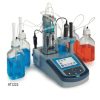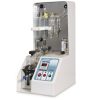TITRALAB AT1000 HACH LANGE:
Reliable results and easy setup.
Since Sulfur is an allergen, in recent years there has been an increase in the demand for wines produced with increasingly reduced quantities of sulphites. This push from the market has led manufacturing companies and research institutes to seek valid alternatives to its use, with a view to guaranteeing the same or similar protective characteristics.
Control of incoming grapes
The incoming grapes must be healthy: if Botrytis cinerea is present, oxidase enzymes responsible for the oxidation of various grape compounds such as polyphenols, aromatic substances, etc. are released.
SO2 inhibits or destroys the effect of the oxidase enzymes in the must, protecting the musts from fermentative oxidations.
Use of inert gases as protection
One of the most effective methods to reduce the amount of sulfur dioxide is to use inert gases during all processing phases, in order to avoid excessive dissolution of oxygen.
CO2 tends to be used in grapes, while nitrogen or mixtures of inert gases are used in conservation or bottling.
° Thiamine (Vitamin B1)
Vitamin B1 limits the formation of compounds such as pyruvic acid and ketogluconic acid that combine SO2, promotes the growth of yeasts by acting on their metabolism.
The concentration of Thiamine depends on the health condition of the grapes. Healthy grapes contain sufficient doses to protect yeasts from SO2 (0.2 to 0.8 mg/L) while diseased or over-ripe grapes have insufficient concentrations.
The Function of Glutathione
Glutathione is a natural compound present in quantity in grapes and in smaller concentrations in must.
It has the characteristic of reducing o-quinones produced by the action of polyphenol oxidase (PPO) on hydroxy-cinnamyl tartaric acids, preventing the formation of phenolic polymers responsible for the browning of musts and white wines
Glutathione, and other sulfur peptides normally contained in yeast in significant quantities, are released into the system by inhibiting the enzymatic mechanisms of browning, contributing to protection against
oxidations.
GSH is initially consumed by yeast during alcoholic fermentation and is released later following cell lysis.
GSH has a protective effect on thiol aromas, and also slows down the formation of an important responsible for the olfactory defect characteristic of the atypical aging of white wines (Sotolon).
Each wine compound is characterized by a redox potential, which allows them to be classified
based on their ease of oxidation: the lower the redox potential, the more easily the compound oxidizes.
Glutathione has a low redox potential (very strong reducing power), so it will be oxidized first, thus protecting the other compounds.
Other compounds have a similar action (SO2, Vit C..) but not as strong as glutathione.












